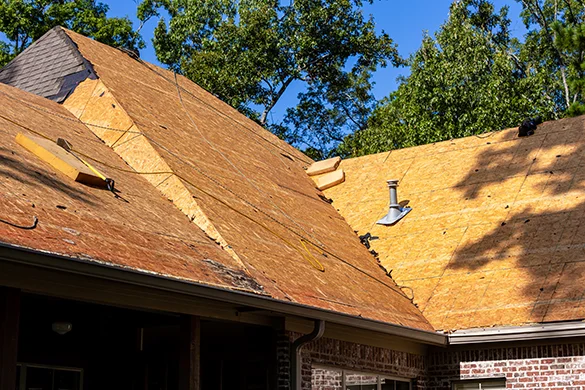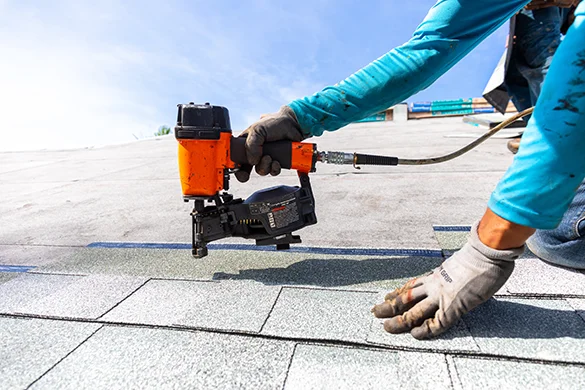Common Siding Repairs: How to Fix and Prevent Exterior Wall Damage
Siding repairs represent critical maintenance tasks that protect your home's structural integrity while preserving property value and curb appeal. Northern Virginia homeowners encounter unique siding challenges from temperature extremes, moisture exposure, and storm damage that demand timely attention. Understanding common siding problems, repair techniques, and preventive strategies empowers homeowners to maintain exterior walls effectively while avoiding costly full replacements. This comprehensive guide examines typical siding damage patterns, repair solutions, and professional approaches ensuring long-term protection for homes throughout Reston, Herndon, and surrounding communities.
Identifying Common Types of Siding Damage
Siding repairs begin with accurate damage assessment recognizing various deterioration patterns affecting different materials. Vinyl siding commonly experiences cracks from impact damage, warping from heat exposure, and loosening from improper installation or high winds. Color fading indicates prolonged UV exposure while chalking—a powdery residue when touched—signals material breakdown requiring attention. Holes from woodpeckers, hail damage, or accidental impact compromise weather protection and aesthetics.
Wood siding shows distinct damage patterns including rot from moisture infiltration, splitting from age and weather cycles, and paint peeling exposing raw material to elements. Insect damage—particularly carpenter ants and termites—creates structural vulnerabilities often hidden behind surface appearances. Warping and cupping occur when moisture content varies between exposed and covered wood surfaces. These conditions escalate quickly without intervention, making early detection essential for successful repairs.
Fiber Cement and Aluminum Siding Issues
Fiber cement siding demonstrates exceptional durability yet encounters specific repair needs over time. Cracking from building settlement or improper installation creates moisture entry points. Chipping along edges from impact damage compromises protective coatings. Joint separation between panels allows water infiltration behind siding systems. Paint failure on fiber cement surfaces requires careful preparation and specialized coating systems matching original finishes.
Aluminum siding faces corrosion challenges particularly along coastal areas or where dissimilar metals contact surfaces. Denting from hail or impact creates permanent deformation requiring panel replacement rather than straightening. Fading and oxidation diminish appearance while chalking indicates coating breakdown. Fastener failure allows panels to loosen, creating noise during wind events and permitting moisture penetration. Understanding material-specific challenges guides appropriate repair strategies for Northern Virginia homes.

Moisture Damage and Water Infiltration Signs
Moisture represents the primary threat to siding longevity regardless of material type. Water stains appearing on interior walls signal siding failure allowing exterior moisture penetration. Mold and mildew growth on siding surfaces indicate trapped moisture within wall assemblies. Bubbling paint on wood siding reveals moisture escaping from behind, while soft spots when pressing siding panels suggest rot development requiring immediate attention.
Efflorescence—white crystalline deposits on siding surfaces—indicates water moving through materials carrying dissolved salts. Ice dams during winter create backup conditions forcing water under siding systems. Gutter overflow or improper drainage directing water against siding accelerates deterioration. These moisture-related issues demand comprehensive solutions addressing both visible damage and underlying water management problems preventing recurrence.
DIY Repairs vs. Professional Siding Services
Homeowners facing siding repairs must evaluate project scope, required skills, and safety considerations when choosing between DIY approaches and professional contractors. Simple repairs like replacing individual damaged vinyl panels, caulking small gaps, or reattaching loose sections suit capable homeowners with proper tools. These limited projects minimize costs while addressing isolated problems quickly. Online tutorials provide guidance for straightforward repairs requiring basic carpentry skills.
Complex siding repairs demand professional expertise ensuring proper execution and long-term performance. Extensive damage spanning multiple panels, structural repairs behind siding, and matching discontinued materials exceed typical DIY capabilities. Professional contractors bring specialized tools, material sourcing capabilities, and installation techniques preventing future problems. Insurance claims, warranty considerations, and building code compliance often require licensed contractor involvement. Understanding these distinctions helps homeowners make informed decisions about repair approaches.
Repairing Vinyl Siding Damage
Vinyl siding repairs follow specific techniques accounting for material properties and installation systems. Cracked panels require complete piece replacement since vinyl cannot be effectively patched. The repair process involves removing damaged sections by unlocking adjoining panels using zip tools, sliding out broken pieces, and installing replacement panels matching color and profile. Proper technique requires understanding interlocking systems and expansion allowances preventing buckling.
Warped vinyl siding often results from improper nailing or heat exposure near grills and reflective surfaces. Repairs involve removing affected panels, identifying underlying causes, and installing replacements with correct fastening techniques. Color matching challenges arise with aged siding requiring careful selection or strategic placement of slightly mismatched panels. Professional contractors maintain material samples and supplier relationships facilitating better matches for Herndon and Vienna area homes.

Wood Siding Repair Techniques
Wood siding repairs range from simple board replacement to extensive rot remediation and structural corrections. Damaged individual boards can be cut out and replaced with matching materials using proper joinery techniques. Rot repair requires removing deteriorated wood beyond visible damage, treating surrounding areas with preservatives, and installing new wood with appropriate moisture barriers and ventilation.
Epoxy consolidation provides solutions for limited rot in ornamental details or hard-to-replace sections. This technique involves drilling holes into damaged areas, saturating wood with epoxy consolidant, and filling voids with epoxy filler creating stable repair foundations. Surface preparation and painting match new repairs to existing finishes. Wood siding repairs demand attention to moisture sources—repairing leaks, improving ventilation, and correcting drainage—preventing recurring problems.
Fiber Cement Siding Repair Procedures
Fiber cement siding repairs require specialized approaches different from vinyl or wood techniques. Cracked panels often can be repaired rather than replaced when damage remains limited. The process involves routing out crack areas, filling with elastomeric sealants or specialized fiber cement fillers, and refinishing to match surrounding surfaces. Proper material selection ensures repairs flex with temperature changes without re-cracking.
Larger damage requires panel replacement following manufacturer guidelines for cutting, fastening, and sealing. Fiber cement cutting produces silica dust demanding proper respiratory protection and dust control measures. Fastener spacing, back-priming cut edges, and maintaining proper gaps prevent future problems. Matching original textures and finishes challenges repairs requiring careful product selection and application techniques. Professional contractors experienced with fiber cement systems ensure repairs meet performance standards while maintaining warranty coverage.
Addressing Underlying Structural Issues
Effective siding repairs often require correcting underlying problems causing surface damage. Water-damaged sheathing beneath siding must be replaced before installing new exterior materials. Rot in wall framing demands structural repairs ensuring adequate support and load-bearing capacity. Inadequate or damaged moisture barriers allow water infiltration requiring comprehensive wall assembly repairs beyond visible siding replacement.
Insulation problems discovered during siding repairs present opportunities for energy efficiency improvements. Adding or upgrading insulation, installing proper vapor barriers, and correcting thermal bridging enhance home performance while addressing structural needs. These comprehensive approaches prevent repeated repairs while improving comfort and reducing energy costs. Professional contractors identify these hidden issues during inspection processes, providing complete solutions rather than superficial fixes for Arlington area properties.

Caulking and Sealing Critical Areas
Proper caulking and sealing represent essential components of comprehensive siding repairs preventing water infiltration and air leakage. Critical sealing locations include joints between siding and trim, around windows and doors, where different materials meet, and at wall penetrations for utilities, lights, and vents. Material selection matters—using paintable acrylic latex caulks for most applications while employing specialized sealants for specific materials and exposure conditions.
Application technique affects longevity with properly prepared surfaces, appropriate bead sizes, and smooth tooling creating effective seals. Old caulk removal before reapplication prevents adhesion failures and uneven appearances. Color-matched caulks blend with siding for aesthetic integration. Regular caulking maintenance every 3-5 years prevents minor gaps from becoming major water damage problems. Understanding these details helps homeowners maintain protective barriers between siding repairs.
Cost Factors for Siding Repairs
Siding repair costs vary significantly based on damage extent, material types, accessibility challenges, and regional market conditions. Small vinyl siding repairs typically range $200-500 for individual panel replacements including labor and materials. Wood siding repairs cost $300-800 per section depending on rot extent and board dimensions. Fiber cement repairs average $400-1,000 considering specialized tools and materials required for proper execution.
Extensive repairs spanning multiple wall sections increase costs to $1,500-5,000 or more when structural corrections accompany siding replacement. Second-story work, complex architectural details, and matching discontinued materials add premium charges. Emergency repairs following storm damage command higher rates reflecting urgency and scheduling disruption. Understanding these cost factors helps homeowners budget appropriately and evaluate replacement versus repair decisions for Northern Virginia properties.
Insurance Coverage for Siding Damage
Homeowners insurance typically covers siding repairs resulting from sudden, accidental damage or covered perils like storms, fire, or vandalism. Wind damage, hail impact, and falling tree limbs generally qualify for coverage subject to deductibles and policy limits. Proper documentation including photos, professional assessments, and detailed damage descriptions support successful claims processing.
Maintenance-related siding repairs, gradual deterioration, and wear from age typically fall outside insurance coverage. Policies exclude damage from lack of maintenance, pest infestations developing over time, and rot from long-term moisture exposure. Understanding coverage limitations guides homeowners in maintaining adequate protection and budgeting for inevitable maintenance expenses. Professional contractors familiar with insurance processes assist with documentation and adjuster communications ensuring fair settlements.

Timing and Seasonal Considerations
Siding repairs benefit from appropriate timing considering weather conditions and material requirements. Spring and fall provide ideal temperatures for most siding work allowing proper adhesive curing, paint drying, and comfortable working conditions. Summer heat creates challenges with vinyl expansion, rapid paint drying, and extreme surface temperatures. Winter repairs face freezing temperatures preventing proper sealant application and material brittleness increasing damage risks.
Urgent repairs addressing active leaks or structural threats require immediate attention regardless of season using specialized materials and techniques for cold weather application. Scheduling non-urgent repairs during optimal conditions ensures better results and contractor availability. Planning repairs during shoulder seasons often provides cost advantages with less demand and more flexible scheduling. These timing considerations help homeowners optimize repair quality and costs.
Preventing Future Siding Damage
Proactive maintenance prevents many common siding repairs through regular inspection and timely intervention. Annual siding examinations identify emerging problems before they escalate into major damage. Cleaning siding surfaces removes mold, mildew, and debris that trap moisture and accelerate deterioration. Trimming vegetation away from siding prevents constant moisture contact and physical damage from branches during storms.
Maintaining proper drainage systems—gutters, downspouts, and grading—protects siding from water exposure causing most damage. Repairing minor issues immediately prevents progressive deterioration requiring extensive corrections. Painting wood siding on appropriate schedules maintains protective coatings preventing moisture infiltration and UV damage. These preventive measures extend siding lifespan while minimizing repair frequencies and costs for Alexandria and surrounding area homes.
Proper Installation and Ventilation
Many siding problems originate from improper installation requiring repairs correcting fundamental issues. Adequate ventilation behind siding systems allows moisture dissipation preventing rot and mold growth. Installing proper moisture barriers, maintaining correct expansion gaps, and following manufacturer fastening specifications prevent premature failures. Understanding these installation requirements helps homeowners evaluate contractor qualifications and recognize improper work.
Attic and wall ventilation systems work synergistically with siding protecting entire building envelopes. Soffit vents, ridge vents, and gable vents promote air circulation preventing moisture accumulation within wall cavities. Correcting ventilation deficiencies during siding repairs provides long-term protection beyond immediate damage restoration. Professional contractors assess these systems comprehensively, ensuring repairs integrate with overall building performance requirements.

Impact Resistance and Storm Protection
Northern Virginia weather patterns including severe thunderstorms, occasional hurricanes, and winter storms create siding damage requiring repairs. Impact-resistant siding materials and proper installation techniques minimize storm damage. Vinyl siding specifications include impact ratings indicating resistance to hail and flying debris. Fiber cement provides superior impact resistance compared to vinyl or wood alternatives.
Proper fastening resists wind uplift preventing siding loss during severe weather. Regular inspection of fasteners, especially after storms, identifies loosening requiring correction before panels detach. Installing storm-rated materials in vulnerable locations—particularly upper floors and windward exposures—provides enhanced protection. These proactive measures reduce repair frequencies while protecting homes from weather-related damage common throughout the region.
Matching Siding for Repairs
Achieving acceptable aesthetic results when repairing siding requires careful material matching accounting for age, fading, and discontinued products. Vinyl siding color shifts over years from UV exposure making new panels appear noticeably different beside aged material. Strategic placement of replacement panels on less visible wall sections or using aged inventory from suppliers minimizes visual impact when perfect matches prove impossible.
Wood siding matching involves selecting proper species, grain patterns, and dimensions replicating original materials. Paint matching requires color analysis accounting for fading and undertone shifts from weathering. Fiber cement repairs demand matching textures, reveal dimensions, and finish colors. Professional contractors maintain material samples, supplier relationships, and finishing capabilities producing better matches than typical DIY approaches. These matching considerations affect repair visibility and overall home appearance.
Warranty Considerations for Siding Repairs
Existing siding warranties may cover certain damage types and manufacturing defects reducing repair costs significantly. Understanding warranty terms, coverage periods, and claim procedures helps homeowners maximize benefits. Manufacturer warranties typically cover material defects while installer warranties address workmanship issues. Proper documentation, using authorized contractors, and following claim procedures protect warranty coverage.
Some repairs void existing warranties when performed improperly or by unauthorized contractors. Reviewing warranty terms before proceeding with repairs prevents inadvertent coverage loss. Professional contractors familiar with warranty requirements ensure compliance while performing necessary work. Repairs under warranty generally require using specific materials and techniques meeting manufacturer specifications. These warranty considerations influence repair decisions and contractor selection for Annandale homeowners.

Upgrading During Repairs
Siding repairs present opportunities for strategic upgrades improving performance beyond restoration of original conditions. Adding insulated vinyl siding during repairs enhances energy efficiency while addressing damage. Upgrading to impact-resistant materials in hail-prone areas reduces future damage risks. Installing improved moisture barriers and ventilation systems during repairs provides long-term protection benefits.
Consider color changes during repairs updating home appearance and addressing fading concerns. Modern siding materials offer enhanced UV resistance, longer warranties, and improved performance compared to older products. These upgrades increase repair costs moderately while delivering substantial long-term value through reduced maintenance, improved protection, and enhanced aesthetics. Discussing upgrade options with contractors ensures repairs address immediate problems while positioning homes for optimal future performance.
Environmental Factors Affecting Siding in Northern Virginia
Northern Virginia's climate creates specific siding challenges requiring awareness and appropriate maintenance responses. Temperature fluctuations between hot summers and cold winters cause expansion-contraction cycles stressing siding materials. Proper installation techniques accounting for these movements prevent buckling, warping, and fastener pullout. Understanding local climate patterns helps homeowners anticipate potential problems and schedule preventive maintenance appropriately.
Moisture from humid summers, frequent thunderstorms, and occasional hurricanes creates ideal conditions for mold, mildew, and rot development. Regular cleaning and prompt leak repairs combat these moisture-related threats. Northern Virginia's tree canopy coverage provides shade but increases debris accumulation and organic growth on siding surfaces. Balancing landscaping aesthetics with siding protection requirements prevents damage while maintaining property appeal throughout the region.
Choosing the Right Contractor for Siding Repairs
Selecting qualified siding repair contractors ensures proper execution and long-lasting results. Verify contractor licenses, insurance certificates, and bonding appropriate for your jurisdiction. Request references from recent siding projects and contact former clients about work quality, communication, and problem resolution. Check online reviews and Better Business Bureau ratings identifying contractors with strong reputations and satisfied customers.
Evaluate contractor expertise with specific siding materials relevant to your repairs. Vinyl, wood, and fiber cement each require specialized knowledge and techniques. Discuss warranty offerings covering both materials and workmanship. Request detailed written estimates itemizing all costs and work scope. Professional contractors provide clear communication, transparent pricing, and quality workmanship ensuring repairs protect your home effectively while maintaining appearance and value for McLean and surrounding communities.

Questions to Ask Potential Contractors
Informed homeowners ask specific questions revealing contractor qualifications and project approaches. Essential questions include: How long have you operated in Northern Virginia? What specific experience do you have with my siding material type? Can you provide detailed references from similar projects? What warranties cover your repair work? How do you handle unexpected discoveries during repairs?
Additional important questions address logistics and communication: What is your estimated timeline for completion? How do you protect landscaping and property during work? What payment schedule do you require? How do you handle weather delays or unforeseen complications? Will you obtain necessary permits and schedule inspections? These questions establish contractor professionalism and help homeowners make informed hiring decisions ensuring successful repair outcomes.
Ready to Address Your Siding Repair Needs?
Common siding repairs protect your Northern Virginia home from weather damage while maintaining curb appeal and property value. Understanding damage types, repair techniques, and contractor selection empowers homeowners to make informed decisions ensuring effective, long-lasting repairs. Whether addressing minor damage or planning comprehensive repairs, professional guidance and quality workmanship deliver peace of mind and superior results.
Reston Roof provides expert siding repair services throughout Northern Virginia, addressing all common damage types with professional techniques and quality materials. Our experienced team identifies underlying problems, recommends appropriate solutions, and executes repairs ensuring long-term protection and aesthetic excellence. We work with all siding materials, handle insurance claims, and provide warranties backing our workmanship. Contact us at (571) 453-6515 to schedule a siding inspection and repair estimate. We'll assess your damage, explain repair options, and provide transparent pricing helping you protect your home investment. Don't let siding damage compromise your home's protection—get the professional repairs you need for lasting peace of mind.
